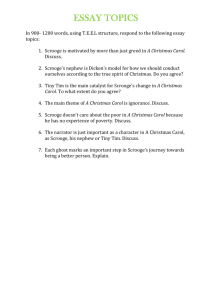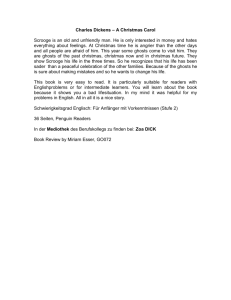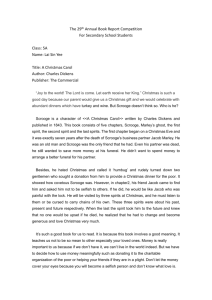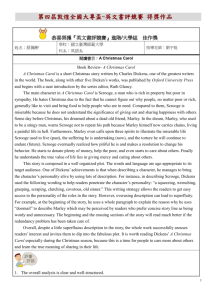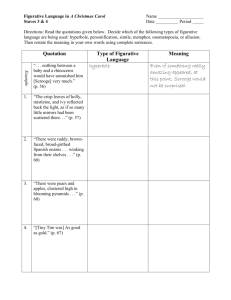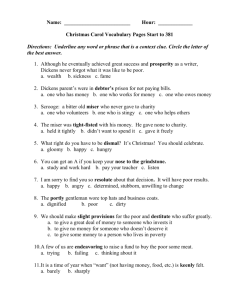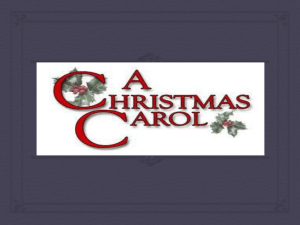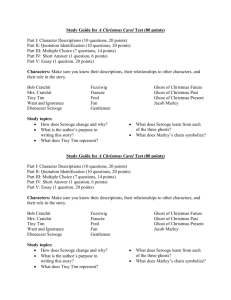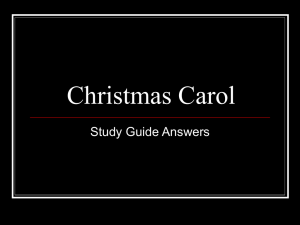A CHRISTMAS CAROL: CONCEPT/VOCABULARY ANALYSIS
advertisement
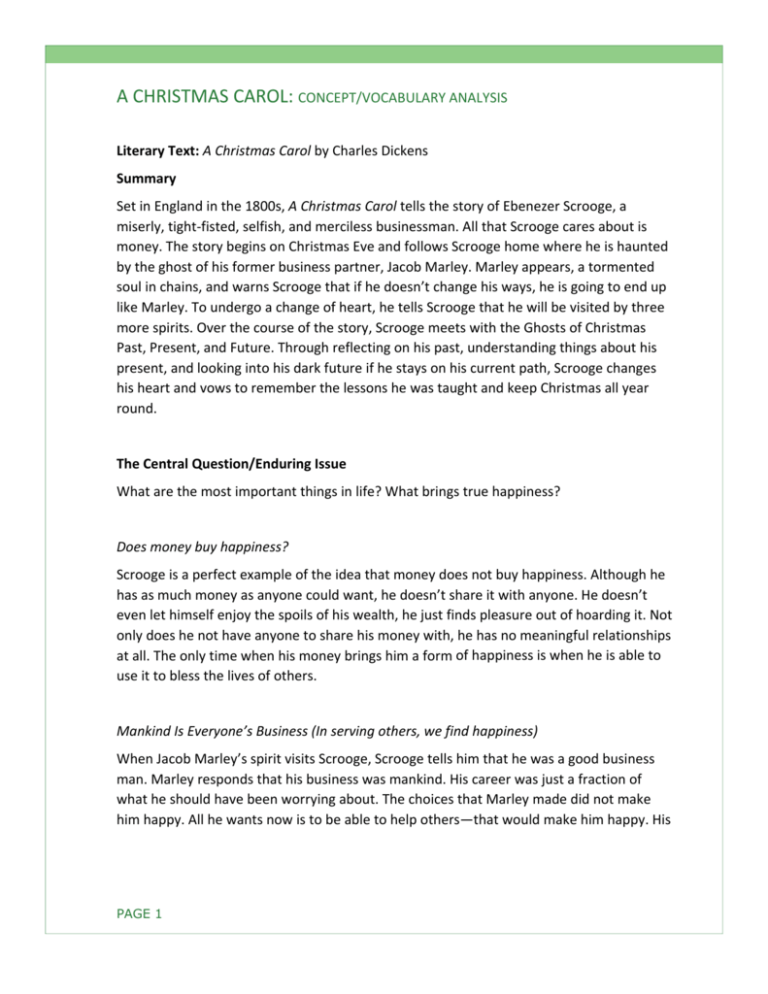
A CHRISTMAS CAROL: CONCEPT/VOCABULARY ANALYSIS Literary Text: A Christmas Carol by Charles Dickens Summary Set in England in the 1800s, A Christmas Carol tells the story of Ebenezer Scrooge, a miserly, tight‐fisted, selfish, and merciless businessman. All that Scrooge cares about is money. The story begins on Christmas Eve and follows Scrooge home where he is haunted by the ghost of his former business partner, Jacob Marley. Marley appears, a tormented soul in chains, and warns Scrooge that if he doesn’t change his ways, he is going to end up like Marley. To undergo a change of heart, he tells Scrooge that he will be visited by three more spirits. Over the course of the story, Scrooge meets with the Ghosts of Christmas Past, Present, and Future. Through reflecting on his past, understanding things about his present, and looking into his dark future if he stays on his current path, Scrooge changes his heart and vows to remember the lessons he was taught and keep Christmas all year round. The Central Question/Enduring Issue What are the most important things in life? What brings true happiness? Does money buy happiness? Scrooge is a perfect example of the idea that money does not buy happiness. Although he has as much money as anyone could want, he doesn’t share it with anyone. He doesn’t even let himself enjoy the spoils of his wealth, he just finds pleasure out of hoarding it. Not only does he not have anyone to share his money with, he has no meaningful relationships at all. The only time when his money brings him a form of happiness is when he is able to use it to bless the lives of others. Mankind Is Everyone’s Business (In serving others, we find happiness) When Jacob Marley’s spirit visits Scrooge, Scrooge tells him that he was a good business man. Marley responds that his business was mankind. His career was just a fraction of what he should have been worrying about. The choices that Marley made did not make him happy. All he wants now is to be able to help others—that would make him happy. His PAGE 1 ROBERTSON, BYU, 2009 torture is that he can’t. When Scrooge changes his life around, he becomes a serving, giving, charitable man. Through this, he is able to find greater happiness. Relationships Bring Happiness There is a great juxtaposition between the lone unhappiness of Mr. Scrooge and the joy that can be found in the homes of Bob Cratchit and Scrooge’s nephew Fred. One major difference is that Bob and Fred have families they love dearly. Although they are both poor, they are extremely happy compared to Scrooge. Organizational Patterns Although A Christmas Carol is in book form, the novel is not broken up into chapters. Instead, Charles Dickens organized the book in five staves. Staves can refer to either a musical staff, or verses or stanzas. This adds additional meaning to the title, A Christmas Carol, as a carol is a festive, often religious song. The book has a very forthright structure— the first stave is the exposition of the novel, setting the stage, the next three staves correspond with the three spirits that visit Scrooge, and the last stave is the conclusion. It is a short book, only about 100 pages in length. Issues related to this study of literature: Theme: Actions and Consequences – The important and lasting consequences that result from our actions, for good or for evil, is a key theme of the novel. For Jacob Marley, the actions that he carried out in life had eternal consequences. He was doomed to roam the earth in chains he forged, desperately craving to help others, but being unable. Marley also refers to the chain that Scrooge is forging, one that is bigger and longer than Marley’s. The reader, along with Scrooge, is also afforded a rare glimpse at actions and consequences through the time traveling aspect of the novel. The actions that Scrooge chose in his past show how he came to be the person in the present. The consequences PAGE 2 ROBERTSON, BYU, 2009 that Scrooge sees from the Ghost of Christmas Future are a result of the actions that he is choosing in the present. The Power of One – Along with the idea of actions and consequences, it would be important to bring up the power of one person to change their community or their world. Scrooge has a great impact on many people in his community: his employees like Bob Cratchit, his nephew, the people he comes in contact with through his business, and other strangers that see him as a prominent member of society. At the beginning of the novel when Scrooge is being horrible, he has a great influence for evil on those in contact with him. He doesn’t contribute money charitably, he works Cratchit to the bone for little pay, he tries to bring his nephew’s spirits down, eventually, Tiny Tim dies because his family didn’t have enough money to give him proper care. However, when Scrooge is using his influence for good, he is able to make so many others happier and better off. He gives his money freely, he takes care of Tiny Tim and the Cratchits, he mends his relationship with his nephew, and in a sense, he reshapes the community. Rebirth – A Christmas Carol is a story that revolves around the rebirth of one man, Ebenezer Scrooge. This is revealed from the beginning of the story when Marley appears to Scrooge. He bluntly tells Scrooge that he is there to give Scrooge a chance to change. This message is repeated by the Ghost of Christmas Past when he says that his mission is Scrooge’s reclamation. Another aspect of the rebirth theme in this novel is that anyone can change, it is never too late. Scrooge is an old man. He has had years of being set in his wicked ways. Still, he is able, through miraculous help, to completely change his nature and become a good, kind, and true man. This theme can bring up interesting classroom discussions on change. This can be a touchy topic though, especially in middle school when the students are insecure enough without lessons on people completely changing their nature. However, it is a valuable concept to think about, especially for kids who may be starting down a path they don’t really want to follow. Setting: PAGE 3 ROBERTSON, BYU, 2009 The majority of the novel is set in London, England in the 19th Century. A significant part of the novel takes place in Scrooge’s dark and dismal home and bedchamber where the ghosts visit him, one after the other. Each of the ghosts take him to different meaningful settings. The Ghost of Christmas Past takes him to familiar scenes from his past: his childhood school, his apprenticeship, his old love’s home. The Ghost of Christmas Present takes him around the town during Christmas day, particularly to Bob Cratchit’s home and his nephew’s home. The Ghost of Christmas Yet to Come takes Scrooge to the back alleys of London in the near future, and revisits the Cratchit’s home. Another significant setting they visit is the churchyard cemetery, specifically Scrooge’s own grave. It is important to note that time is a large part of the setting in this story. Point of View: The novel is a little complicated in its point of view. Throughout the majority of the novel, the story is told in third‐person limited with Ebenezer Scrooge as the character through whose eyes the reader views things. The reader follows Scrooge the whole time, listens to his thoughts, and sees what he sees. However, there is also an amount of first‐person narrative to the story. The reader is positively aware that the story is being told by a narrator, for he randomly interjects comments or jokes throughout the story. The identity of the narrator is never explicitly said, however, it seems that Charles Dickens himself is supposed to be the narrator. It isn’t a stretch to imagine him writing the story and including his humorous little thoughts in the text. The author’s preface to the book also makes it seem like the author is particularly present in the story. Allusion: This novel uses many allusions, both literary and religious. When Scrooge travels back to his childhood, he reflects upon the books he used to read as a boy. Some of the books are named by title, but others are referenced through a character name or line. At another point in the novel, the narrator makes a humorous reference to Hamlet’s father while talking about ghosts. The allusion will most likely need explanation for the students to understand the humor. PAGE 4 ROBERTSON, BYU, 2009 Similarly, many Christian and Bible references appear in the book. Some Christian students will get these allusions, although some are still obscure. Students may need help understanding these references. Affective Issues related to the work Because A Christmas Carol was written so long ago, and the society seems so different from now, it could seem irrelevant to students. This is why it is so important for pertinent themes and applicability to be brought out and focused upon. First, focus on the element of the supernatural in the story, especially the initial haunting by Marley. Ghost stories are fun and exciting. Much of required reading for students doesn’t indulge in ghosts to the extent that A Christmas Carol does. Second, this book is fun to read in the weeks leading up to Christmas. There aren’t many stories as festive as A Christmas Carol. It would be a great way to harness the excitement that builds as Christmas break draws near. Another reason this book is relevant to students is that it focuses on questions that arise around Christmas time every year. What is Christmas all about? What is really important in life? How am I treating others? Am I doing what I can to make the world a better place? These questions often arise in the minds of adults, but they apply to teenagers just as much. In schools there isn’t usually much opportunity to discuss morals or ideals, but this book is a fairly non‐threatening or –invasive way to talk about those topics. Finally, the novel is applicable to teenagers because it focuses on learning a major lesson and turning your life around. How many times in life does a person learn a major lesson? How many times does it significantly affect your life, or turn it around? Has this ever happened to you? All of these questions are extremely relevant to teenagers who are developing, learning and growing daily. Some of them have already had to make huge life adjustments, and some are on the road to doing that. It would be positive to be able to have a medium through which to discuss this important issue. Vocabulary Issues This novel was written in the 1800s and by Charles Dickens nonetheless. Many of the words in the novel are advanced, use British spellings, or are outdated and make little sense in a modern vocabulary. With these thoughts in mind, the vocabulary in the book is often quite advanced for students in middle school and possibly early high school. Nearly PAGE 5 ROBERTSON, BYU, 2009 every page contains some tricky words that may require teacher scaffolding. One positive thing about A Christmas Carol is that it is such a familiar story. Most students will have seen at least one movie version of the story or possibly been read an abridged version as a younger child. Because the story is so familiar, students will have an easier time following the plot despite the vocabulary distractions. However, vocabulary instruction should be incorporated in some way. It might be helpful to create and study a vocabulary list prior to reading each stave. Background Knowledge As previously stated, most students will be familiar with A Christmas Carol before reading it. This can be an advantage because they will be familiar with the story, the setting, the characters, etc. However, some preparation before reading will definitely help students get into the mindset of a 19th Century author. For example, it might be helpful to briefly study Charles Dickens’ life and works to see where A Christmas Carol fits in and why he was motivated to write it. It would also be beneficial to understand some of the economic situation in 19th Century England so that the juxtaposition between the wealthy and the poor is fully understood. A final bit of background information that might be more fun than necessary would be a brief study of Victorian Age Christmas traditions. Implications for Students of Diversity A Christmas Carol does not involve a diverse ethnic or cultural population. All of the characters are white and most of them are male. However, race and ethnicity is not the only way for a book to be diverse. The book focuses intensely on the dichotomy of the rich and poor. Characters with wealth and characters begging on the street are both portrayed. While this helps to make the book more versatile, it could have possible negative complications for students whose families struggle with money. They may be more sensitive to discussing money issues, or it could provide them with a deeper personal connection. The book also comes from a very Christian standpoint. Students who have been raised Christian will most likely relate better to the story. They will understand many of the Christian allusions as well. It is possible that students or the parents of students who are of different religions that do not celebrate Christmas could be offended by a book that PAGE 6 ROBERTSON, BYU, 2009 focuses so highly on the holiday. However, the book does focus on many non‐religion specific, good qualities and habits that everyone should develop. Gender Issues As mentioned in the previous paragraph, the majority of the characters in A Christmas Carol are male. Amy female characters that appear in the story are minor characters at best. The few female characters with roles big enough to mention include: Scrooge’s little sister, Scrooge’s brief love interest, Mrs. Cratchit and her daughters, and Scrooge’s niece. Each of these women follows the 19th Century stereotype of femininity. Scrooge’s little sister, Fan, is a “delicate creature” with a “large heart”. Scrooge’s love interest, Belle, is a dower‐less but beautiful maiden. Mrs. Cratchit is the typical housewife, cooking a fabulous Christmas feast with her limited means and mothering her little brood. Scrooge’s niece is “exceedingly pretty”, with “a ripe little mouth that seemed made to be kissed” and “the sunniest pair of eyes you ever saw”. Each of these characters is rather stereotypical and one‐dimensional. This could be frustrating for a classroom full of modern females. Research/Project Ideas Personal Narrative/Reflection Have students brainstorm about a time when they or someone close to them had a major change of heart or learned a lesson. Students should reflect on why it was important for them to change their opinion or actions. What motivated them or sparked them to change? Is this a lesson everyone should learn? Small group service project Students will break up into groups and brainstorm ideas for service projects in the classroom, school, or community. The teacher will need to be a strong resource for the students to make this project work. An entire class service project might be easier for the teacher to manage, but students will be less individually accountable for participating. At Christmas time, service projects should abound and be easier to garner participation from outside the class. Students could run a Secret Santa program for the school or a school food drive. The class could adopt a family for Christmas. PAGE 7 ROBERTSON, BYU, 2009 This project would offer many writing opportunities. Students could write the forms, fliers, or announcements to publicize the project. Students could write poems to go along with the Secret Santa gifts. Students could write reflections on the service project and their personal reaction to it. Enrichment Resources Movies: There are a myriad of movies created about A Christmas Carol. Some of them include: A Muppet Christmas Carol, Mickey’s Christmas Carol, numerous live action A Christmas Carol movies, and even a new animated movie starring Jim Carrey as Scrooge and all three ghosts. Any of these movies could be shown in clips to aid the students in comprehension of the text. A movie could also be used as a reviewing activity after the class has finished all the assigned reading. Similarly, a movie could be watched as a reward at the end of the unit. Websites: Numerous websites like the one listed below offer extended amounts of biographical information on Charles Dickens and his works to help with gaining background knowledge. http://www.online‐literature.com/dickens/ PAGE 8 ROBERTSON, BYU, 2009 PAGE 9 ROBERTSON, BYU, 2009 PAGE 10
